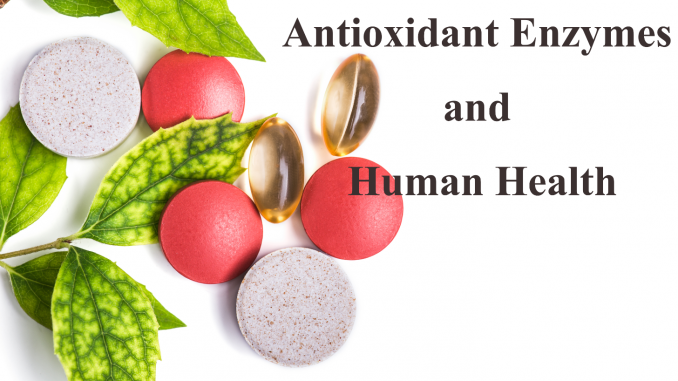
Introduction
During normal metabolic functions, highly reactive compounds called free radicals are generated in the body; however, they may also be introduced from the environment. These molecules are inherently unstable as they possess lone pair of electrons and hence become highly reactive. They react with cellular molecules such as proteins, lipids and carbohydrates, and denature them. As a result of this, vital cellular structures and functions are lost and ultimately resulting in various pathological conditions.
Antioxidant enzymes are capable of stabilizing, or deactivating free radicals before they attack cellular components. They act by reducing the energy of the free radicals or by giving up some of their electrons for its use, thereby causing it to become stable. In addition, they may also interrupt with the oxidizing chain reaction to minimize the damage caused by free radicals. It has been found that a substantial link exists between free radicals and more than sixty different health conditions, including the aging process, cancer, diabetes, Alzheimer’s disease, strokes, heart attacks and atherosclerosis. By reducing exposure to free radicals and increasing the intake of antioxidant enzyme rich foods or antioxidant enzyme supplements, our body’s potential to reducing the risk of free radical related health problems is made more palpable. Antioxidant enzymes are, therefore, absolutely critical for maintaining optimal cellular and systemic health.
Free radicals and their scavengers
Free radicals are electrically charged molecules, i.e., they have an unpaired electron, which causes them to seek out and capture electrons from other substances in order to neutralize themselves. Although the initial attack causes the free radical to become neutralized, another free radical is formed in the process, causing a chain reaction to occur. And until subsequent free radicals are deactivated, thousands of free radical reactions can occur within seconds of the initial reaction.
The ability of the cell to utilize oxygen has provided humans with the benefit of metabolizing fats, proteins, and carbohydrates for energy; however, it does not come without cost. Oxygen is a highly reactive atom that is capable of becoming part of potentially damaging molecules commonly called free radical or reactive oxygen species (ROS). About 5% or more of the inhaled O2 is converted to ROS such as superoxide, hydrogen peroxide, and hydroxyl radicals by univalent reduction of O2. Thus cells under aerobic condition are always threatened with the insult of ROS, which however are efficiently taken care of by the highly powerful antioxidant systems of the cell without any untoward effect. This antioxidant system includes, antioxidant enzymes (e.g., SOD, GPx and reductase, CAT, etc.), nutrient-derived antioxidants, metal binding proteins and numerous other antioxidant phytonutrients present in a wide variety of plant foods. Whenever the balance between ROS production and antioxidant defence is lost, ‘oxidative stress’ results which through a series of events deregulates the cellular functions leading to various pathological conditions.
Antioxidant protection system
To protect the cells and organ systems of the body against reactive oxygen species (ROS), humans have evolved a highly sophisticated and complex antioxidant protection system. It involves a variety of components, both endogenous and exogenous in origin, that function interactively and synergistically to neutralize free radicals. These components include:
| Endogenous Antioxidants | Dietary Antioxidants | Metal Binding Proteins |
|
|
|
Antioxidant enzymes in health
Antioxidants are of different types so that they might be available for action when and where they are needed. They are natural (enzymes antioxidants and metal carrier proteins in the body), scavenging or chain breaking (like vitamin A, C, beta-carotene, etc.), pharmacologic antioxidants and others. Antioxidant compounds must be up’’ (converted) in the process of neutralizing free radicals. Therefore, one must continually produce more of the antioxidants in the body or ingest them either in diet or by supply mentation. The repair enzymes that can regrate some antioxidants are SOD, GPx, glutathione reductase (GR), CAT and the other metalloenzymes.
Other antioxidants
Dietary Antioxidants
Vitamin C, vitamin E, and beta-carotene are among the most widely studied dietary antioxidants. Vitamin C is considered the most important water-soluble antioxidant in extracellular fluids. It is capable of neutralizing ROS in the aqueous phase before lipid peroxidation is initiated. Vitamin E, a major lipid-soluble antioxidant, is the most effective chain-breaking antioxidant within the cell membrane where it protects membrane fatty acids from lipid peroxidation. Vitamin C has been cited as being capable of regenerating vitamin E.
Beta-carotene and other carotenoids are also believed to provide antioxidant protection to lipid-rich tissues. Research suggests beta-carotene may work synergistically with vitamin E. A diet that is excessively low in fat may negatively affect beta carotene and vitamin E absorption, as well as other fat-soluble nutrients. Fruits and vegetables are major sources of vitamin C and carotenoids, while whole grains and high quality, properly extracted and protected vegetable oils are major sources of vitamin E.
Phytonutrients
A number of other dietary antioxidant substances exist beyond the traditional vitamins discussed above. Many plant-derived substances, collectively termed “phytonutrients,” or “phytochemicals,” are becoming increasingly known for their antioxidant activity. Phenolic compounds such as flavonoids are ubiquitous within the plant kingdom: approximately 3,000 flavonoid substances have been described. In plants, flavonoids serve as protectors against a wide variety of environmental stresses while, in humans, flavonoids appear to function as “biological response modifiers.” Flavonoids have been demonstrated to have anti-inflammatory, antiallergenic, anti-viral, anti-aging, and anti-carcinogenic activity. The broad therapeutic effects of flavonoids can be largely attributed to their antioxidant properties. In addition to an antioxidant effect, flavonoid compounds may exert protection against heart disease through the inhibition of cyclooxygenase and lipoxygenase activities in platelets and macrophages.
Reference:
Krishnamurthy P, Wadhwani A. Antioxidant Enzymes and Human Health. Antioxidant Enzyme, 2012.

Leave a Reply